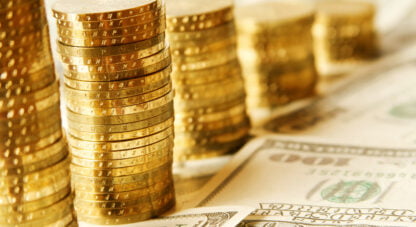10 Questions You Should Ask Before Buying Collectible Coins
At this time in the market for semi-numismatic coins, we feel it is imperative that you be more knowledgeable as to what a collectable coin is. Because we guarantee to buy back these coins at the same grade, we, as a dealer, consider several factors that our coins must have in order to guarantee our own liquidity. Liquidity is to collectible coins what location is to real estate.
Therefore, we use these criteria, to help us determine what types of coins will be desirable and easily liquidated. In considering any type of collectible coin, you should do the same.
I. Was the coin minted prior to 1934? – After 1934, the U.S. and the rest of the world, discontinued to mint coins as legal tender. Any coins minted after 1934, were minted for bullion reserve purposes, and are not considered legal tender coins.
II. Is the coin uncirculated, and how can you tell? Consider this question… Would you expect an uncirculated, 100 year old coin, to be dull with tiny scratches or bright and shiny? If you answered dull, you are right. In it’s original condition, an old coin tends to be dull or hazy, and may have a few tiny scratches. If the coin is bright and shiny, and you see no scratches, typically this indicates that someone has buffed or cleaned the coin. A shiny coin attracts customers looking for the wrong thing. Eye appeal is important, but a true uncirculated coin, should be purchased in it’s original condition – not an altered one.
III. In the future, will a dealer pay you a premium for the coin? Almost all old coins carry collectible premiums, however, there are several coins currently being promoted as collectibles. It doesn’t always mean a dealer at some future time will be willing to pay a collectible premium for the coin. If you follow these guidelines, they will protect you from buying an illegitimate coin. You should carefully consider all of these points. You should not disregard a single one when choosing a coin.
IV. Has the coin ever been re-struck ? In some instances, coins were reproduced by a country reusing an old design cast to make the coin. For instance, the Swiss and French 20 francs were reproduced in the mid 1940’s using old die casts, bearing an older date. Anyone wondering what happened to the gold stolen by the Nazi’s may want to consider this. Austrian Ducats, bearing the date 1915, are currently being reproduced, are offered as old coins, and are selling for a premium. This creates a problem for the coin as a collectible, because at this point, no one knows the true population of the coins made with that date, nor how to tell the old from the new. To better understand this problem, imagine Chevrolet reproducing 10 million more exact replicas of the 57 Chevy. Then try to imagine convincing someone they were really built in 1957, once the news got out.
V. Is the coin protected from confiscation? A precedence was set by our country when Franklin D. Roosevelt instituted Executive Orders recalling gold bullion in exchange for paper currency. This effectively pulled real money out of the hands of the public, and put a currency that could be easily reproduced into circulation. The only gold people were allowed to own was in jewelry and collectible coins. In our country, if martial law is declared, and executive orders are enforced, they will also institute exchange controls. At that moment, our borders will be closed to prevent any wealth from leaving the country, any foreign paper currency you own will be called in and made illegal, and any bullion you have in your possession will also be called in and made illegal.
Collectible coins are far less likely to be confiscated, because of the government’s inability to determine collectible value. Even if this were to change, and governments go after collectibles at some point, you will have bought more time, with collectibles, to be legal for as long as possible. When Stalin and Hitler confiscated gold, they did not confiscate collectible coins. But eventually, they declared certain segments of their populations to be spiritually or politically incorrect, and seized everything from those people. A sobering thought for Christians and politically incorrect traditionalists in America .
VI. Is the coin non-dealer reportable and privateHaving dealt with this issue earlier, we would like to reiterate two concerns. First, for dealers to take advantage of any exceptions, real or imagined, to 1099 Dealer Reporting requirements, they risk an IRS audit of their client’s transactions to verify compliance. We are not willing to use the exceptions for that reason. We would rather “chew our arm off†than to fill out 1099 forms.
However, we will report the liquidation of even a single gold coin to avoid an IRS fishing expedition. A wise man once observed, “Do you know what happens if you let a camel stick his nose under your tent flap? Pretty soon, you have a camel in your tent.†Second, protecting your privacy today insures your legal ownership from confiscation in the future.
VII. Does the coin have a low mintage? It is not necessary for a coin to be “rare†strictly by population, but for a coin to have collector appeal, it must have some scarcity or rarity. Although the majority of old U.S. coins have significant populations, what makes them rare is the condition they survived in. However, if a coin has a low mintage population, this too, can play a significant role in its rarity value.
VIII. Is the coin under-valued or over-valued? In other words, does the coin have genuine upside potential, or is it over-priced at this time. This could be important in determining if a coin is currently over promoted by dealers.
For instance, during the Y2K scare, many dealers promoted cheap double eagles as a barter coin that was protected from confiscation. These circulated coins were only $80 to $100 above their gold value and seemed like a good buy compared with uncirculated double eagles. After Y2K, many discovered these coins were only worth their melt value.
In 1998, ICA began recommending old, uncirculated, European coins with sizes and premiums similar to modern fractional bullion coins. This helped our clients avoid big losses with the barter portion of their portfolio.
IX. Is the coin over-graded? All too often coin dealers are unwilling to take responsibility for the accuracy of the grading of a coin. Therefore, they typically will only guarantee the coin according to the current grading service standards. This actually poses a problem, especially if the standards change in the coin grading services. In the face of strong market demand, coin grading standards can loosen up in order to supply more coins into the market.
So, what happens to the standards when the opposite takes place, and suddenly there is no demand, or even a market sell-of? Here at ICA , we guarantee to buy back your coin at the same grade we sold it to you. This insures that no matter what the current standards are at the time, we know that the coins we sell you now will stand up to any standard being used in the future.
X. Is the dealer reputable and well capitalized? There are over 5000 coin dealers currently in existence in the United States . Of those there are only a hand full of reputable, established dealers in this industry having the knowledge to truly give their clients the best service. ICA has a 28 year history of buying and selling precious metals. ICA is one of the largest dealers in the country. This insures our ability to provide a two-way market, and give you the proper perspective.
All too often most people are not given enough of the right information to make a good decision. ICA believes that the integrity, information, and coins we provide to our clients has been, and will continue to be, at the highest standard by which the rest of the industry will be measured against. Like Grandpa McCoy was fond of saying “ It ain’t bragging when you done done itâ€















